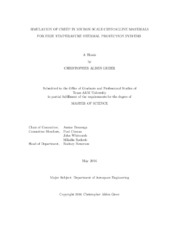| dc.description.abstract | The use of thermal barrier coatings over the past few decades has significantly improved the performance of gas turbine engines by reducing the operating temper-ature of engine components. However, these multilayer systems are not able to be used to their full potential due to the difficulty of accurately modeling the complex interplay of physical phenomena, such as creep and oxidation, that contribute to failure. In order to address this issue, more physics-based failure prediction models need to be developed. One potential way to do this is through the use of dislocation dynamics (DD) models. A DD framework was recently developed which incorporates high temperature effects such as vacancy diffusion assisted dislocation climb in ad-dition to dislocation glide. However, the effects of certain parameters on simulations of dislocation creep had been unexplored. In particular, the effect of the distance required for a dislocation to climb to a new slip plane, the critical climb distance, was not evaluated and the vacancy relaxation volume was set at zero, negating its effect on the calculation of vacancy diffusion. The present work aims to address this by studying the effect of the critical climb distance and the vacancy relaxation volume on the creep response of micron scale single crystals. The critical climb distance was found to have an approximately inversely proportional effect on the steady state creep rate, but did not affect the stress dependence of the creep rate, while the use of a nonzero vacancy relaxation volume was found to have a slight effect on both the steady state creep rate and the stress dependence of the creep rate. Furthermore, the use of a nonzero vacancy relaxation volume introduced the effect of the pressure gradient into the vacancy diffusion simulation. | en |


